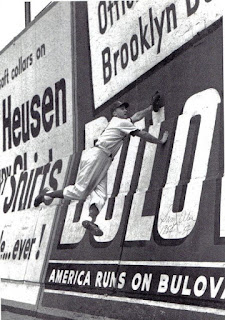Duke Snider made an award winning grab on Memorial Day in 1954 that still stands as the best ever, yes, even better than Willie Mays' grab in the 1954 World Series. The catch is one of many highlights detailed in Jason Aronoff's "Going, Going ... Caught!: Baseball's Great Outfield Catches as Described by Those Who Saw Them, 1887-1964
In baseball circles, one just has to say “The Catch” and immediately visions of Willie Mays racing towards the depths of the Polo Grounds appear. While many regard Mays tracking down Vic Wertz’s smash as the best ever, some witnesses argued Mays’ catch wasn’t even the best one that year! The recently deceased Duke Snider made a snag on Memorial Day earlier that year that easily rivaled, if not surpassed Mays’ highlight in New York.
The Brooklyn Dodgers were facing the Philadelphia Phillies at Connie Mack Stadium in Philadelphia on May 31, 1954. Entrenched in a 12-inning battle, Phillies third baseman Willie “Puddin Head” Jones stepped to the plate against Clem Labine. Jones laced a screaming shot towards the left-center field gap that forced Snider into an all-out sprint towards the wood-faced concrete wall. Snider miraculously managed to dig his foot into the wall and propelled himself seemingly higher to reach out over his head and across his body to make a spinning backhanded catch against the fence. He stumbled down the wall and pulled the ball out of the webbing of his glove. Second base umpire Jocko Conlan signaled the out and the Dodgers mobbed Snider for preserving the victory.
The Brooklyn Eagle’s Dave Anderson labeled Snider’s grab as, “the greatest, absolutely the greatest, catch in baseball history.” Dodgers coach Jake Pitler told the New York Post that Snider’s catch was like no other he witnessed in baseball.
“In forty years of baseball, I never saw a catch like Snider made.”
In a 2009 interview I conducted with Dodger outfielder Don Thompson, he gave me a bird’s-eye view from his position in left field, where he was inserted as a late inning defensive replacement.
“A man in upstate New York contacted me about a book he was writing about baseball’s greatest catches," Thompson said. He asked me about a catch Duke Snider made on Memorial Day in 1954. I was in the field, as I went in during the 8th or 9th inning. Snider made a catch you wouldn’t believe unless you were there to see it. Puddin Head Jones hit a ball to left-center field; Snider had a better shot at it than I did. He was running towards the fence, jumped and turned, and sorta stuck his cleats in the wooden fence there and caught this ball. It may have gone over, but he jumped and turned and caught this ball. This author rated this number one. Snider was going right towards the fence as hard as he could, turned at the last minute, stuck his cleats in the fence and caught this ball. He rated it over Mays’ catch in the World Series. Mays had a long way to go, but he didn’t have anything obstructing him. Alston said not only did he have a long way to go, he had to jump, and he had the fence to contend with. I was playing left field, I was right there. He stuck his cleats in that old fence, and I couldn’t believe that he had it. He backhanded it for the catch.”
Bob “Mickey” Micelotta was on first base when the ball was hit. Micelotta was a rookie infielder for the Phillies, making only his third plate appearance in the major leagues. He drew a walk off of Labine to extend the inning for Jones’ drive. There was some speculation Snider trapped the ball against the wall with his near-impossible catch. In a July 2009 letter from Micelotta, he affirmed Snider’s awe inspiring leap.
“I did see the catch," Micelotta said. "I was on first base and the play was right in front of me. He did catch it!”

